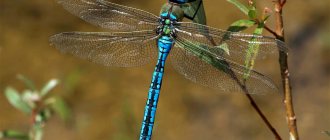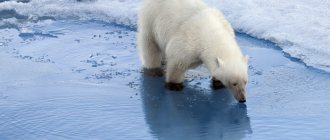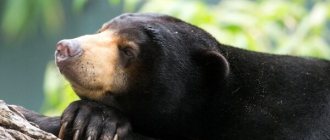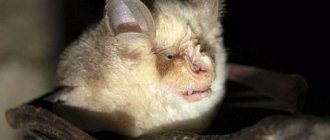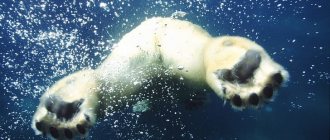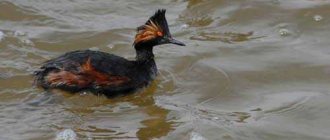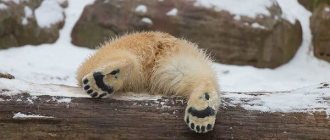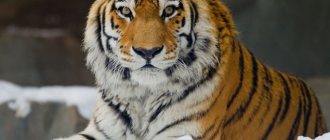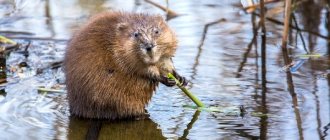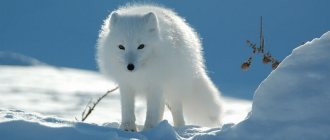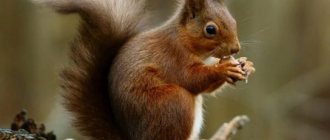Who among us doesn’t know who a bear is and has never even seen one in a picture? Let's get to know this smart and beautiful animal better, learn amazing facts from his life and broaden the horizons of our children.
A stately, large, shaggy animal, which we always consider clumsy, clubfooted and clumsy, is in fact completely different from our ideas. This is a strong, brave and dexterous forest dweller who can easily show “where crayfish spend the winter,” especially if he is in a bad mood.
The bear is a large mammal with thick fur that protects its skin. It has sharp claws on its powerful paws, which help it in hunting. It is one of the bearish representatives. The closest relatives are the fox, wolf and dog. The bear can swim, run fast, overcome obstacles and climb trees. The bear is omnivorous by nature, loves meat and fish, but he is also not averse to eating honey, berries, grains, tasty grass, roots and fruits.
For the winter, almost all bears go into hibernation in their den, having previously eaten to their fill. If a bear is hungry in the fall, then it wakes up and wanders through the forest in search of food, for which it is called a connecting rod bear.
At the very end of winter, the bear gives birth to offspring. Sometimes it’s two or three little bear cubs, or even all five cubs. At birth, the cubs weigh only about 500 grams and are completely defenseless, so at first they are completely dependent on their parents.
Curious facts about the bear
Any animal is a mystery to humans, and that is why it is so interesting to discover their world, get to know each other better and learn new things. Here are some interesting facts about the bear that people know:
- All bears fall asleep in winter. Pandas and polar bears never hibernate.
- During winter sleep, bears lose up to 50% of their body weight.
- Forest bears, for example, grizzlies or brown bears, are excellent tree climbers, especially cubs. With age, the desire to climb trees subsides somewhat.
- Polar bears are the only ones that prefer meat exclusively, while others are actually omnivores.
- A cute panda is also a bear.
- A large polar bear can eat about 70 kilograms of meat in one meal, and a small panda can eat about 20 kilograms of bamboo.
- It is noteworthy that the bear was a symbol of the 1980 Olympics, held in the USSR.
- The bear's white fur hides black skin.
- The bear is clumsy only in appearance. In fact, over short distances it will give even any professional athlete a head start, reaching speeds of up to 55 kilometers per hour.
- Bears are smart animals. They can easily spot a bear trap and throw a stick into it to disarm it. They also understand perfectly how to get honey from the hive without being bitten.
The character and lifestyle of the brown bear
Brown bears are territorial loners. The territory of a male can be up to 400 km², while that of females with offspring is 7 times less. Each bear marks the boundaries of its territory with scent marks and scratches on tree trunks. Animals lead a sedentary life, wandering only in the direction of areas with more accessible and plentiful food, or away from humans.
One of the characteristic features of a bear’s behavior is its persistence. Stubbornness manifests itself both when obtaining a large amount of food and for the sake of a piece of delicacy.
So, in late autumn, seeing a lonely fruit hanging on an apple tree, the bear will first try to reach, then try to climb, and having failed on the flexible branches, it will begin to shake the tree until it takes possession of the apple.
Another trait inherent in bears is an excellent memory. They are easy to train, especially at a young age, and are incredibly intelligent. Many hunters note that bears who have previously seen a trap and its work throw large stones or sticks at it, and, having neutralized it, eat the bait.
Bears are very curious, but they try to avoid meeting people. But if this happens, the behavior of the animal depends largely on when it noticed the person and who was there before.
He can watch people picking berries or mushrooms, and then appear in all his splendor, irritated by someone's loud scream or laughter. After this, he usually makes a small but sharp leap forward, snorts with displeasure, but does not attack.
A minute later, the owner of the forest turns around and slowly leaves, looking back several times and stopping. Rapid mood changes are the norm for bears.
Another example is when a bear encounters a person by chance and suddenly, being frightened, as a rule, empties its intestines. This is where the name “bear disease” comes from.
It's no secret that brown bears hibernate. Before settling down for the winter, they feed especially actively to accumulate enough fat. The weight of a brown bear sometimes increases by 20% in autumn. Going to the place of the den (a depression filled with windbreaks or a secluded place under the roots of a fallen tree), the bear meanders, confusing its tracks.
The bear remains in suspended animation for 2.5 to 6 months, depending on its habitat and climatic conditions. During sleep, body temperature remains at 34°C. Males and females expecting offspring sleep separately. Mother bears with first-year cubs lie down together. Paw sucking is typical only for babies.
A bear's dream is very sensitive. If you wake him up in the middle of winter, he will no longer be able to go back to sleep and will wander through the snowy forest, scanty for food, angry and irritated.
The worst thing is to meet a connecting rod bear. Unlike other times, he will definitely attack. During the hibernation period, the weight of a brown bear decreases by an average of 80 kg.
How to draw a bear
When studying a bear with your children, try making it out of plasticine, paper or other materials. And also take advantage of our master class. You will learn how to draw a bear step by step and draw it yourself:
What to read and watch with children about bears?
We offer you a number of riddles, tongue twisters, sayings, poems, fairy tales, films and cartoons in which one of the main characters is a bear.
Riddles about the bear
A riddle about a bear for children will give children the joy of discovery and confidence in their abilities. The joy of the exclamation “I guessed right!” - incomparable with anything)))
The owner of the forest wakes up in the spring, And in winter, to the howl of a blizzard, He sleeps in a snowy hut. (Bear)
In the summer he walks without a road near the pines and birches, and in the winter he sleeps in a den, hiding his nose from the frost. (Bear)
This funny animal is made of plush: it has paws and ears. Give the beast some honey and make him a den! (Bear)
The beast waddles along raspberries and honey. He loves sweets very much. And when autumn comes, He climbs into the hole until spring, where he sleeps and dreams. (Bear)
Clubfoot and shaggy, He warms his paws in the den. In the summer he loves to go for walks and protect animals. And in winter, under the blizzard howl, He sleeps in a snowy hut. (Bear)
The furry beast loves honey. If he doesn’t understand something, He may roar wildly, Because he... (Bear)
Tongue twisters about a bear
Tongue twisters are very useful for developing speech and diction, and besides, they are terribly fun. And it’s just wonderful that there are thematic tongue twisters, in our case, about a bear:
Mila washed the bear with soap, Mila dropped the soap, Mila dropped the soap - she didn’t wash the bear with soap.
Mishka walked and found a cone. She sat down and began to eat a lot, but Mishka gobbled up the cone too much.
The bear growled in the den, The marmot remained silent in the hole. They growled, remained silent - and woke up at dawn.
Proverbs and sayings about the bear
From time immemorial, wild bears have attracted human attention. Man's careful observations have yielded important truths. Proverbs and sayings are the wisdom of our ancestors and a storehouse of knowledge. Just don’t forget to explain to your children the true meaning of the sayings.
- The bear sucks one paw and lives well all winter.
- And they teach the bear to dance.
- The bear dances and the gypsy takes the money.
- Two bears do not live in the same den.
- Don't sell the skins without killing the bear.
- The mare competed with the bear, but only her tail and mane remained.
- The owner of the house is like a bear in the forest.
- The bear is not the cow's brother.
- The bear has nine songs, all about honey.
- The bear is clumsy and hefty.
- A bear in the forest is like a boyar in the city.
- It's good to tease a bear out the window.
- Taken by surprise and the bear is cowardly.
Appearance and behavior
The length of the animal’s body reaches two to two and a half meters. His head is heavy, with a large forehead and small ears. The eyes are also small, deep-set. The nose is black. The bear has thick, long fur, from under which its short tail is almost invisible. Wool comes in different shades: from black to straw. His claws are scary - they reach 10 centimeters. It weighs more than half a ton and seems awkward. But the animal runs fast, makes huge jumps, climbs trees, and swims well. He also rears up and moves through the forest silently and carefully. As you know, he walks with a clubfoot. In water, the bear does not like to dive and keeps its head on the surface.
Fairy tales, stories, fables about the bear
Bear is one of the classic traditional heroes of various fairy tales, including folk and original ones, so there is no shortage of works. Here are the brightest of them, which are definitely worth reading with your baby.
- Russian folk tale "Masha and the Bear"
- Russian folk tale "The Man and the Bear"
- Leo Tolstoy's tale "The Three Bears"
- Fairy tale by Mikhail Yasnov “Enko the Bear”
- The fairy tale “The Half-Minded Bear” translated by Vladimir Dahl
- Stories by Vitaly Bianki about a bear
- Fable by Ivan Krylov “The Hardworking Bear”
- The wonderful story of Alan Milne "Winnie the Pooh and all-all-all"
I also have a fairy tale about Teddy Bear and his friends, about a magical little laugh, and also about the first lesson at forest school.
What helps you survive in the North
Fur covers the paws of polar bears, even on the soles, so that they can move on ice without slipping or freezing. There are membranes between the toes - this helps animals swim well in search of food. They can hold large prey with their huge claws.
Despite their great height and weight, these animals are very agile and fast. Their vision is excellent. Endurance allows them to walk and swim tens of kilometers when they hunt or look for a suitable place to rest or live.
It's not scary with mom. Photo: flickr.com/beingmyself
Bear cubs
Cubs are born in snow dens, where pregnant females lie down in the fall. Once every 2–3 years, 1–3 babies are born weighing 450–600 g and about 30 cm in length. The cubs are blind, deaf, and have light skin. After a month, their eyes and ear canals open. After another month, teeth erupt.
In the spring, the cubs, under the supervision of their mother, crawl out of the den.
Rice. 2. The exit of a polar bear cub from the den.
Grown-up cubs stay with the mother bear for up to 1.5 years. The mother feeds them milk, teaches them to hunt, and protects them from adult males who can attack teenagers.
Rice. 3. Polar bear with cubs.
Hunting and food
When hunting, polar bears hear sounds and smell smells from afar, even from under the thickness of ice and snow. Alone, they fish, patiently watch for seals and walruses, cleverly camouflage themselves and sneak up on them. If necessary, they dive and turn over ice floes. They do not enter their neighbors’ territory and do not interfere with each other’s hunting. In the summer, when the ground thaws a little, the bears also feed on plants - moss and berries.
The bear loves to eat fresh fish. Photo: flickr.com/johnvetterli
